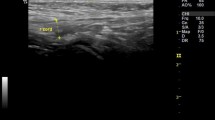Abstract
We present our experience with the transinguinal diagnostic laparoscopy and discuss its efficacy in evaluating the contralateral side in unilateral inguinal hernias. The possible influence of the initial side of hernia, age and gender on recognized bilateralism were also evaluated in two study groups (diagnostic laparoscopy vs clinical diagnosis). In this retrospective study, we evaluated 36 bilateral, 158 left-sided and 303 right-sided consecutive inguinal hernia cases. A total of 211 out of 461 unilateral cases underwent hernia repair and transinguinal laparoscopic evaluation of the contralateral side. Complications and difficulties of the technique, the mean duration of laparoscopy and operative times were additionally analyzed from operation charts. In this study, bilateralism was determined by transinguinal laparoscopy in Group 1 (children with a contralateral patent processus vaginalis) and clinically in Group 2 those who had a metachronous hernia. The patients were also analyzed according to the side of the inguinal hernia, age and gender in both groups. We found an overall positive contralateral patency in 41 cases (19.4%). We failed to perform a successful diagnostic laparoscopy in six cases (2.7%). No anesthetic or surgical complications were noted. Transinguinal laparoscopy did not add any considerable time to the mean operation time. The incidence of bilateralism in Group 1 was higher in girls than boys. Clinically detected bilateralism was significantly higher in 0–6 month age group and contralateral patency detected via laparoscopy was high in all other age groups. We may conclude that transinguinal diagnostic laparoscopy is a feasible technique in children. We advocate its use as a tool with minimal complication risk even in the hands of novice.




Similar content being viewed by others
References
Skoog SJ, Conlin MJ (1995) Pediatric hernias and hydroceles the urologist’s perspective. Urol Clin North Am 22:119–130
Duckett JW (1952) Treatment of congenital inguinal hernia. Ann Surg 135:879–885
Miltenburg DM, Nuchtern JG, Jaksic T, et al (1997) Meta analysis of the risk of metachronous hernia in infants and children. Am J Surg 174:741–744
Miltenburg DM, Nuchtern JG, Jaksic T, et al (1998) Laparoscopic evaluation of the pediatric inguinal hernia—a meta-analysis. J Pediatr Surg 29:874–879
Levitt MA, Ferraraccio D, Arbesman MC, et al (2002) Variability of inguinal hernia surgical technique: a survey of North American pediatric surgeons. J Pediatr Surg 37:745–751
DuBois JJ, Jenkins JR, Egan JC (1997) Transinguinal laparoscopic examination of the contralateral groin in pediatric herniorrhaphy. Surg Laparosc Endosc 7:384–387
Gardner TA, Ostad M, Mininberg DT (1998) Diagnostic flexible peritoneoscopy: assessment of the contralateral internal inguinal ring during unilateral herniorrhaphy. J Pediatr Surg 33:1486–1489
Geisler DP, Jegathesan S, Parmley MC, et al (2001) Laparoscopic exploration for the clinically undetected hernia in infancy and childhood. Am J Surg 182:693–696
Guvenc BH (2001) Diagnostic laparoscopic evaluation of the contralateral internal ring: the search for a prospective hernia. Pediatr Endosurg Innovative Tech 5:259–265
Surana R, Puri P (1993) Fate of patent processus vaginalis: a case against routine contralateral exploration for unilateral inguinal hernia in children. Pediatr Surg Int 8:412–414
Wulkan ML, Wiener ES, VanBalen N, Vescio P (1996) Laparoscopy through the open ipsilateral sac to evaluate presence of contralateral hernia. J Pediatr Surg 31:1174–1176
Miranda ME, Lanna JCBD (2002) Video laparoscopy of the contralateral internal inguinal ring via the hernia sac in children with unilateral inguinal hernia—initial experience in Brazil, with meta-analysis. Pediatr Surg Int 8:463–469
Owings EP, Georgeson KE (2000) A new technique for laparoscopic exploration to find contralateral patent processus vaginalis. Surg Endosc 14:114–116
Schier F, Danzer E, Bondartschuk M (2001) Incidence of contralateral patent processus vaginalis in children with inguinal hernia. J Pediatr Surg 36:1561–1563
BhatiaAM, Gow KW, Heiss KF, et al (2004) Is the use of laparoscopy to determine presence of contralateral patent processus vaginalis justified in children greater than 2 years of age? J Pediatr Surg 39:778–781
Gorsler CM, Schier F (2003) Laparoscopic herniorrhaphy in children. Surg Endosc 17:571–573
Fernandes GJM, Prates JC (1997) Inguinal rings: a morphometric study on Brazilian male newborns. Rev Chil Anat 15:187–192
Fuenfer MM, Pitts RM, Georgeson KE (1996) Laparoscopic exploration of the contralateral groin in children: An improved technique. J Laparoendosc Surg (Suppl 1):1–4
Panton NM, Panton RJ (1994) Laparoscopic hernia repair. Am J Surg 167:535–537
Nixon RG, Pope JC IV, Adams MC, et al (2002) Laparoscopic variability of the internal inguinal ring: review of anatomical variation in children with and without a patent processus vaginalis. J Urol 167:1818–1820
Rescorla FJ, West KW, Engum SA, et al. (1997) The “other side” of pediatric hernias: the role of laparoscopy. Am Surg 63:690–693
Kaufman A, Ritchey ML, Black CT (1996) Cost-effective endoscopic examination of the contralateral inguinal ring. Urology 47:566–568
Liu C, Chin T, Jan SE, Wei C (1995) Intraoperative laparoscopic diagnosis of contralateral patent processus vaginalis in children with unilateral inguinal hernia. Br J Surg 82:106–108
Zitsman JL (1996) Transinguinal diagnostic laparoscopy in pediatric inguinal hernia. J Laparoendosc Surg 1(Suppl 6):15–20
Chu CC, Chou CY, Hsu TM, et al (1993) Intraoperative laparoscopy in unilateral hernia repair to detect a contralateral patent processus vaginalis. Pediatr Surg Int 8:385–388
Ulman I, Demircan M, Arikan A, et al (1995) Unilateral inguinal hernia in girls: is routine contralateral exploration justified? J Pediatr Surg 30:1684–1686
Author information
Authors and Affiliations
Corresponding author
Rights and permissions
About this article
Cite this article
Sözübir, S., Ekingen, G., Şenel, U. et al. A continuous debate on contralateral processus vaginalis: evaluation technique and approach to patency. Hernia 10, 74–78 (2006). https://doi.org/10.1007/s10029-005-0047-1
Received:
Accepted:
Published:
Issue Date:
DOI: https://doi.org/10.1007/s10029-005-0047-1




